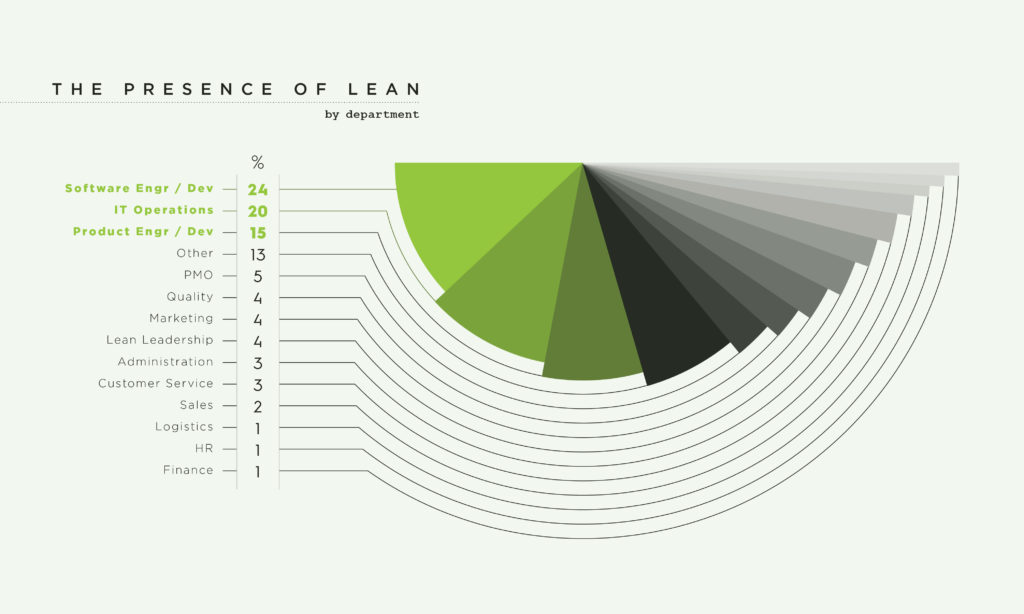
Different companies have different cultures, but timesheets are almost universally abhorred by the work force — and yet they continue to stick around. Why? Because timesheets are acutely intertwined with traditional IT budgeting processes. While workers may be peeved at the inconvenience of timesheets, leadership is looking to them to answer vital questions. Questions like:
- How predictable are we — do we consistently deliver value?
- Are we efficient — what is the capacity utilization of the staff?
- Are we straying from our budget — projected cost vs. actual cost?
- Is the headcount and skillset right — does the current staff level serve the organization well?
These questions all feed into the more strategic question: How do we efficiently run our business in a fiscally responsible manner? How do we, as a large enterprise, remain relevant and even thrive in an increasingly competitive economy? This is where Lean comes in.
Lean Transformations, Not Lean Accounting
Loosely defined as a strategy of flow efficiency, with key principles of just-in-time and visual management, Lean is a scientific approach to developing products and delivering them fast.
Some perceive Lean as a start-up phenomenon, but the Lean movement touches some of the largest enterprises in the world. As enterprises are undergoing Lean transformations, many of them run into the same problem: How do we practice continuous improvement in Lean, while maintaining the traditional accounting practices on which we make all of the strategic decisions as an organization?
Lean Accounting
In an effort to learn more about what to do about this Lean stumbling block, I found some fascinating articles on Lean Accounting. To be clear: I’m not an expert in finance or accounting by any means. I write this post because viable options are available to mitigate this issue and are worthy of consideration. For those suffering from cumbersome accounting processes, and ripe for trying something new to move forward in your Lean transformation, read on.
Lean Accounting: What’s It All About?
In Brian Maskell and Bruce Baggaley’s article, Lean Accounting: What’s It All About?, the authors explain an alternative approach to traditional accounting practices, based on Lean principles. The authors explain that: “Everybody working seriously to implement Lean thinking in their company eventually bumps up against their accounting systems. It soon becomes clear that traditional accounting systems are actively anti-Lean.” This is the dilemma I mentioned above.
While Maskell and Baggaley’s article is written for manufacturing organizations, I see no reason why it could not apply to knowledge work. In fact, Planview AgilePlace’s Lean Business Report validates this assumption: Finance departments are one of the last remaining holdouts in Lean transformations (read the full report here).

A Real-Life Example
To demonstrate the reality of timesheets, let’s examine a real-life example:
It’s 4:45 PM on a Friday. Jim sets his TechOps work aside to complete his weekly timesheet. He doesn’t exactly remember everything he did this week, but he gives it a go:
- There was a request to estimate some architecture rework required for a new project, but there’s no place to charge time against projects not fully funded yet.
- Jim also helped run down a production issue on Tuesday, but there’s nowhere to charge time for unplanned work.
- There’s also no spot for the overhead of time unrelated to project tasks — like the merit reviews that are due this week.
Rather than fret about it, Jim puts in some ballpark numbers, calls it good and gets back to work, relieved to be done on time for a change.
The Problem with Timesheets
To clarify, the timesheets I’m discussing are not used for billing or compensation purposes. They are completed by professional exempt, full-time, salaried employees to track hours towards projects. So when I use the word “timesheets” from here on, I mean survey-based activity timesheets used for the management of projects.
The scenario I described above is the reality of using a survey-based timesheet process for IT project budgeting purposes. There’s no incentive to do it well. Jim doesn’t use the timesheet data to make any decisions. Neither do his direct reports, nor his boss. Jim’s boss cares that the timesheet gets done. Period. It’s a bureaucratic checkbox.
Jim is close enough to his team’s work to make decisions based on observations, experience, and team performance metrics. The people who might benefit from the data, like the Project Management Office (PMO) and the accounting department, are several steps removed, and not in a good position to ensure compliance. And so, the data is incomplete at best — and more often than not, inaccurate. This contributes to the inconvenient truth that the timesheet results are not truly valuable to the whole organization.
A Brief History of Timesheets
The timesheet data submitted by Jim’s team is inaccurate. Jim knows it. Jim’s boss knows it. The project managers know it. Given the lack of evidence on their value, many workers question the validity of the timesheet requirement. But they understand that there is a concrete reason for having some record of their activity, and at the risk of appearing less productive or compliant than their peers, they complete the timesheets out of obligation. This is a far cry from the original intent of the timesheet.
If you loathe timesheets, you can blame a lawyer named Reginald Heber Smith for inventing them. Influenced by Frederick Winslow Taylor and his theory of scientific management, Smith introduced the timesheet, to (in his own words), “let the work in the office flow where it will be done best, most quickly, and at lowest cost.” In other words, to help employees work better, faster, cheaper.
The Lean Argument Against Activity-Based Accounting
Timesheets have come a long way since Smith introduced them in the legal profession in the early 1920s to bill customers in six-minute increments. These days, activity-based timesheets are used to plan for and adjust project budgets, and to estimate skillsets and resources needed to meet future demand. Companies need to know how many people they can hire and how much money to budget for.
The budgeting process typically begins with the program managers who build business cases using estimates for projects. Once a project and its associated budget is approved by senior leadership, the project manager (PM) keeps a sharp eye on the project costs. Many PMs are held accountable for their project budget. When the PM sees that the project exceeds its budget run rate (the total number of hours worked x hourly rate, totaled up for all project workers), they may need to go ask for more money.
The problem here is twofold: First, there’s risk in making decisions based on inaccurate data. The inaccurate, activity-based timesheet data is used to calculate project run rates, which are often incorrect. Then, prioritization decisions are driven by run rate data — data that is estimated at best, and in no way reflects how much value is created for the customer.
Secondly and more importantly, this approach emphasizes activity over value. Activity-based accounting is unrelated to the delivery of business value. Tracking the number of hours Jim spent working on a project task does not reflect the business value delivered — it just reflects how many hours he spent working on it.
The Danger of Activity-Based Accounting
Imagine if we used a similar method to assess someone who makes sandwiches. If we know whether they spent five minutes or 30 minutes making a sandwich, do we know anything about the quality of the sandwich they made? Do we know whether the recipient of that sandwich was satisfied with his or her meal? Do we know how we can improve future sandwiches? No. We only know how long it took to make a sandwich.
Similarly, the customer doesn’t care how many hours Jim spent working on line item 236. Measuring activity incentivizes people to max out their capacity. The reality is that a team loaded to 100% capacity is much like a freeway at 100% capacity — a parking lot (learn more about this concept here). Correlating activity with business value is risky, because high activity levels do not equate to high business value.
Measuring Workflow Efficiency with Lean Accounting
Instead of spending time managing a budgeting process using estimates and error-prone timesheets, Lean accounting invests in people, measures business value, and improves an organization’s products and services.
In their article available from the Scaled Agile Framework, Lean and Agile Financial Planning, Rami Sirkiä and Maarit Laanti echo Maskell and Baggaley’s sentiments on how enterprises experience financial control as a restriction.
Both articles share insights for how to evolve from traditional, project-based resource allocation and cost accounting to a leaner, faster, lower-overhead, decentralized financial management model. Details include removing wasteful practices such as long-horizon detailed cost estimates, and involving the people required to achieve the results in the planning and goal-setting for their own areas of responsibility.
Back to Our Example: A Lean Accounting Transformation
The large global company with $2 billion in annual IT spend where Jim works is undergoing a Lean transformation. Here’s how they’re managing it:
Team
First off, teams are trained on Lean flow metrics such as flow efficiency, cycle time, throughput, and cost of delay. Work is pulled by product teams as determined by the prioritization policy.
In a product-oriented world, it makes sense to organize teams around products instead of projects. Fewer interdependencies across functional teams saves time and reduces coordination costs.
Product-oriented teams also make cost accounting easier. They have a predictable run rate based on the salaries of the team members. Cycle time metrics, which measure elapsed time to build and deliver value, are easier to measure for one product team, than across disjointed project teams.
Tooling
The decision filter hierarchy starts with business value, then workflow efficiency, and then removal of waste from the system. The company uses a Lean work item tracking system (like Planview AgilePlace) making it relatively easy to measure workflow efficiency. Unlike timesheet data, employees like Jim actually benefit from putting their work in the tracking system because it helps them collaborate with their teammates. They are motivated to record accurate data.
Metrics
Lean and Agile practices encourage team members to break work down as granularly as possible, to improve predictability, collaboration, and quality, and this makes for an increasingly accurate picture of where time was spent. Metrics on time spent actively working are automatically captured — at no extra cost — and can help teams and organizations learn to improve their flow efficiency. This is something timesheets could only dream of doing.
Flow metrics like cycle time, when viewed at the product level, provide an easier way to see relevant problems that impact the product itself. Flow metrics can be used to forecast future business requests with a high degree of accuracy — again, without additional cost. The data is already there in the tracking system as a result of just doing the work.
Change Management
Jim’s IT management team is re-examining timesheet tracking to see if it should still play a role (unlikely).
How will the CFO and the finance team adjust? The IT management belief is that the reduction of waste from removing low-value tasks will free up finance people’s time to allow them to be more actively involved in business improvements.
In Short: The Need for Lean Accounting
Timesheets measure activity only and capture questionable data. Correlating activity with business value is risky, as busy people alone do not create business value. Traditional accounting systems often cripple Lean transformations, triggering companies to investigate a healthier approach — a Lean accounting approach.
Lean accounting does not require traditional activity-based accounting methods. Instead, Lean accounting focuses on delivering business value, improving products and services and doing away with wasteful practices.
Lean accounting actively drives Lean transformations, giving companies better information for decision-making. This helps companies grow, adds more value for customers, and ultimately adds value for the shareholders and owners.

![A Global Collaborative Work Management Blueprint [Video]](https://blog.planview.com/wp-content/uploads/2019/07/A-Global-Collaborative-Work-management-blueprint.png)


